Walking along the coast and observing the rocks that emerge in the area of Le Castella, one is looking at evidence of a sea that existed in the recent past (60,000 years ago), remarkably similar to the one explored today while snorkeling or diving in front of the Aragonese Castle. The territory where the village now stands has evolved over time, undergoing various paleoenvironmental phases tied to the natural evolution of the area.
From a strictly geomorphological perspective, marine terraces are coastal parallel surfaces, raised or gently inclined toward sea level, bordered inland by a typically steep cliff. Their formation corresponds to cycles of sea-level rise (transgression) and fall (regression), a phenomenon that has occurred repeatedly and with relative regularity since the Pleistocene epoch. Marine terraces generally feature an erosional surface at their base, a sign of rising sea levels, upon which large basal conglomerate boulders—formed by the sea’s erosive action during transgression—accumulate. Marine sediments, deposited during these cycles, lie atop these boulders, with varying characteristics depending on the extent of sea-level changes. The terrace deposits terminate when the sea naturally recedes.
The uplift tectonics of the Crotone peninsula explain the elevation of these deposits, which can be admired today while walking along the coast. The territory of the Crotone peninsula is characterized by at least five marine terraces, the result of the interaction between sea-level variations during the Middle and Late Pleistocene (between 774,000 and 11,700 years ago) and Calabria’s gradual uplift from the Middle Pleistocene to the present (fig. 1). The highest terraces are the oldest. The rocks that compose these terraces preserve traces of the marine paleoenvironment in which they formed and are rich in fossils. Strolling through the Crotone peninsula, one frequently encounters rocky outcrops from these marine terraces that preserve spectacular examples of fossil algal reefs (bioconstructions) and ancient seabeds composed almost entirely of calcareous shells from marine organisms.
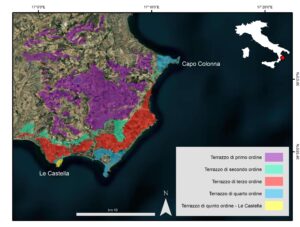
The coralligenous bioconstruction (or Coralligenous) is the most common rock found within the terrace deposits of this territory. It appears as a white rock with a highly porous and irregular surface (fig. 2a). It is characterized by meter-scale structures with irregular development, distributed more or less continuously across various outcrops. Upon closer examination, the coralligenous rock reveals numerous white, highly irregular laminae (fig. 2b). These are encrusting red calcareous algae whose cells have mineralized walls made of calcium carbonate. When alive, these algae are usually pink or red due to accessory photosynthetic pigments and are known as “living rocks” because of their hardness. Calcareous algae have been the most important platform-building organisms in the Mediterranean Sea since the Pleistocene and still form geomorphologically complex environments (fig. 2c), which support high biodiversity.
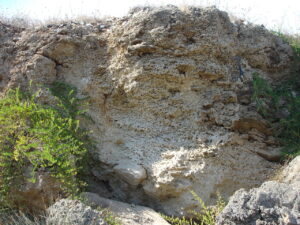
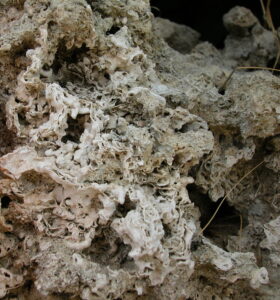
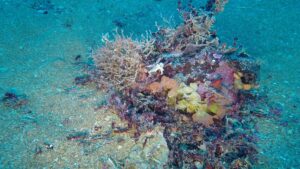
Fig. 2. The coralligenous bioconstructions of the Le Castella terrace: a) an outcrop showing the presence of both coralligenous bioconstruction and biocalcarenite; b) a close-up of the bioconstruction, highlighting algal crusts that, over geological time, formed meter-scale structures; c) an example of coralligenous bioconstruction.
At Le Castella, where a marine terrace dating back about 60,000 years emerges, the bioconstruction features species of calcareous algae that indicate a shallow paleoenvironment during its formation. Between these bioconstructions, one frequently encounters biocalcarenites.
Biocalcarenites are sedimentary rocks formed by the cementation of accumulated biological remains, such as the endo- and exoskeletons (shells) of unicellular and multicellular marine animals. The biocalcarenites in the Crotone area are meter-scale structures that often preserve sedimentary features revealing past hydrodynamic energy. They are characterized by very coarse grains (fig. 3a). Upon close inspection, one can easily observe that they are composed almost entirely of fossilized shells (fig. 3b).
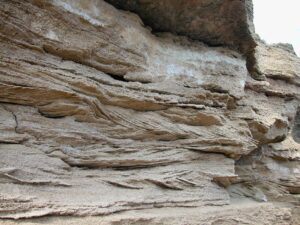

Fig. 3. The biocalcarenites of the Le Castella terrace: a) an outcrop displaying thick sandstone layers with evident sedimentary structures; b) a close-up of the biocalcarenite, where grains ranging in size from millimeters to centimeters are visible, all composed of the exoskeletons (shells) of marine organisms.
Credits
DISAT – Dipartimento di Scienze dell’Ambiente e della Terra – Università di Milano-Bicocca